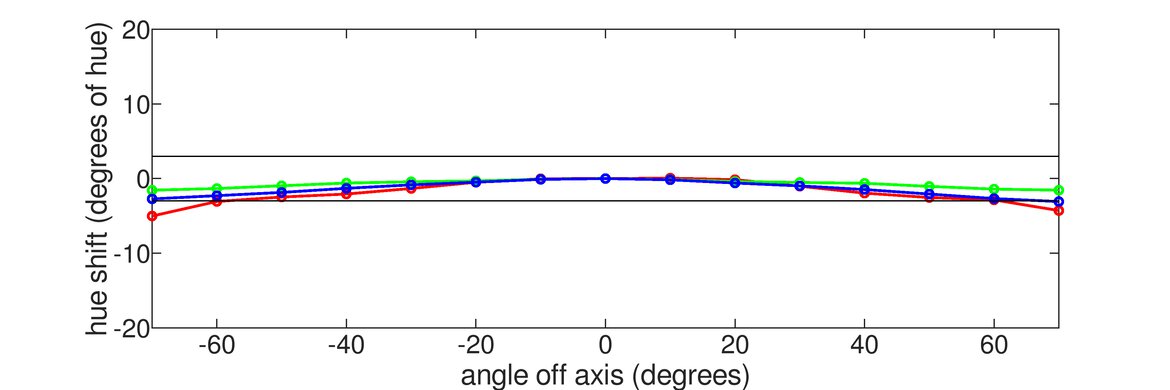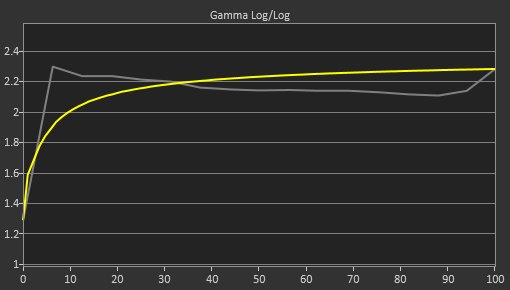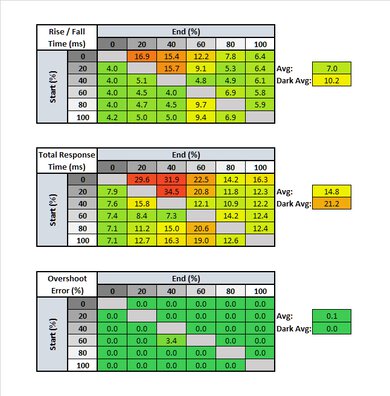The Dell S3220DGF is an impressive 1440p gaming monitor. It has a curved design and it doesn't take up much room, even with the support stand attached. Gaming feels responsive due to the fast refresh rate and low input lag. Also, the native FreeSync support should help reduce any screen tearing. It can display deep blacks in a dimly lit room thanks to its VA panel's high contrast ratio. That said, its viewing angles are inadequate, which means that images look washed out when viewed from the side. It has decent reflection handling and okay peak brightness, making it suitable for a moderately-lit room, but visibility can be an issue if there's direct light.
Our Verdict
The Dell S3220DGF is a good monitor for mixed use. It has a large size and its 1440p resolution allows for a good amount of multi-tasking, but it doesn't offer as much real estate as a full 4k screen would. It has low input lag, and the fast response time ensures that motion blur is minimal in fast-moving scenes. Also, it has a good contrast ratio and black uniformity, which means content looks good in a dark room. That said, viewing angles are disappointing, which results in images looking washed out when viewed from the side.
- Very low input lag.
- Excellent gray uniformity.
- 165Hz refresh rate.
- Very good contrast ratio.
- Image degrades when viewed from the side.
- Response time slower than other similar monitors.
- Monitor can't rotate into portrait mode.
- Okay black uniformity.
The Dell S3220DGF is a good monitor for office use. It has a large screen size and high resolution, which allows you to have multiple windows open side-by-side. It has decent reflection handling and gets bright enough to overcome glare. The ergonomics are only okay, as it can't rotate into a portrait mode, and the picture quality suffers when looking at it from a side angle.
- Excellent gray uniformity.
- Very good contrast ratio.
- Large 1440p screen.
- Image degrades when viewed from the side.
- Monitor can't rotate into portrait mode.
The Dell S3220DGF is an impressive gaming monitor. It has a very low input lag, which ensures a responsive gaming experience. It has FreeSync technology for reducing screen tearing and its fast response time ensures that motion blur is minimal in fast-moving scenes. While its response time isn't as good as other 165Hz monitors, it should still be good enough for most people.
- Very low input lag.
- 165Hz refresh rate.
- Large 1440p screen.
- Response time slower than other similar monitors.
The Dell S3220DGF is a good monitor for multimedia use. Its screen size is large and it has a high resolution, which allows for a more immersive experience. It's decent at handling reflections and overcoming glare. Also, its low input lag makes it very responsive. That said, its viewing angles are disappointing, resulting in the image looking washed out when viewed from the side.
- Excellent gray uniformity.
- Large 1440p screen.
- Image degrades when viewed from the side.
- Okay black uniformity.
The Dell S3220DGF is a very good monitor for content creators. It's pretty large with a high resolution, which is optimal for displaying multiple windows side-by-side. Ergonomics are only okay, as there's no portrait mode, but it's easy to adjust it into a comfortable position. Unfortunately, viewing angles are disappointing as the image quality degrades when viewed from the side.
- Excellent gray uniformity.
- Very good contrast ratio.
- Large 1440p screen.
- Image degrades when viewed from the side.
- Monitor can't rotate into portrait mode.
- Okay black uniformity.
The Dell S3220DGF is a decent choice for HDR gaming. The high contrast ratio makes blacks look deep in a dark room. It can display HDR games with bright, vivid colors due to its wide color gamut and decent HDR peak brightness, but lacks any local dimming feature. On the upside, it has outstandingly low input lag and a good response time overall.
- Very low input lag.
- Very good contrast ratio.
- Large 1440p screen.
- Okay black uniformity.
- No local dimming.
- Only decent HDR peak brightness.
Changelog
- Updated Jan 16, 2023: Clarified that the monitor's max Refresh Rate over HDMI is 144Hz and it can't be overclocked.
- Updated Jul 04, 2022: There was a mistake in the 60Hz input lag results. We remeasured the input lag at 60Hz, and it's 0.6ms higher than our original results.
- Updated Dec 07, 2020: We've corrected the number of USB ports available.
- Updated Oct 21, 2020: Updated review for accuracy and clarity.
Check Price
Differences Between Sizes And Variants
We tested the 32 inch Dell S3220DGF, which is the only size available.
If someone comes across a different type of panel or if their Dell S3220DGF doesn't correspond to our review, let us know and we'll update the review. Note that some tests, such as gray uniformity, may vary between individual units.
Update 09/11/2020: It appears that the June 2020 revision (A03) of this monitor behaves a bit differently, adding a default 120Hz refresh rate, and removing the 144Hz option.
The Dell S3220DGF we tested was manufactured in August 2019.
Popular Monitor Comparisons
The Dell S3220DGF is a curved gaming monitor with great gaming performance. It has a low input lag and supports FreeSync, but its response time is slower than other 165Hz monitors. See also our recommendations for the best gaming monitors, the best curved monitors, and the best 1440p monitors.
The Dell S3220DGF is better than the Dell S3222DGM overall, but the differences might not matter to everyone. The S3220DGF supports HDR, it has better ergonomics, and it has better connectivity, with a built-in USB hub. For gaming, the S3222DGM is a better choice, as it has an optional black frame insertion feature and a faster response time.
The Dell S3422DWG is much better than the Dell S3220DGF. The S3422DWG has a faster response time, better black uniformity, and a higher-resolution screen, resulting in better text clarity. The S3422DWG also has an optional backlight strobing feature. The S3220DGF has better ergonomics, with a better height adjustment, and the base can swivel.
The Dell S3220DGF is better overall than the AOC CQ32G1. The Dell has a higher refresh rate, as well as a much better response time, it supports HDR, and the screen has better uniformity. However, the AOC gets brighter, it has wider viewing angles, the out-of-the-box color accuracy is better, and it has a black frame insertion feature to clear up motion blur.
The Dell S3220DGF and the Samsung Odyssey G70D S32DG70 are different types of gaming monitors. The Samsung has a higher 4k resolution, resulting in more detailed images with sharper text, and it takes full advantage of gaming consoles. The Samsung also gets brighter, making it better to use in well-lit rooms, but the Dell's higher contrast ratio makes it the better choice for dark rooms.

We buy and test more than 30 monitors each year, with units that we buy completely on our own, without any cherry-picked units or samples. We put a lot into each unbiased, straight-to-the-point review, and there's a whole process from purchasing to publishing, involving multiple teams and people. We do more than just use the monitor for a week; we use specialized and custom tools to measure various aspects with objective data-based results. We also consider multiple factors before making any recommendations, including the monitor's cost, its performance against the competition, and whether or not it's easy to find.
Test Results

The Dell S3220DGF's design is quite similar to most other Dell monitors, only that the logos on the front and back of the screen are blue. It's a fairly large screen, and while the stand is larger than some of the other Dell monitors on the market, it's still not very big.
The back of the monitor is plain. Cable management is serviced through the stand, and it has a quick-release button.
The Dell S3220DGF doesn't have a local dimming feature. The above video is provided for reference only.
The Dell S3220DGF has decent peak brightness. It should be able to combat glare in most rooms, although you should avoid placing it in a very bright one. If you need a brighter screen, increasing the contrast results in a noticeably brighter, but less accurate image. If you want something that gets significantly brighter with real content, look into the ASUS TUF Gaming VG27WQ1B.
The Dell S3220DGF has decent HDR peak brightness. It can bring out highlights in HDR, but there's a slight variation in brightness with varied content.
As is the case with most VA panel monitors, the horizontal viewing angle is disappointing. You quickly lose image accuracy when viewed from the side, and since it has such a large screen, the sides of the screen appear darker if you sit too close. If you're interested in a VA panel with fairly wide viewing angles, check out the AOC CQ32G1.
The monitor has a disappointing vertical viewing angle. You lose image accuracy if it's mounted above or below eye level. Also, if you sit close to the screen, the top and bottom edges appear darker.
The Dell S3220DGF has excellent gray uniformity, better than most monitors we've seen, but this could vary from unit to unit. The sides of the screen appear darker mainly due to the viewing angles, but other than that, you shouldn't notice any uniformity issues.
The pre-calibration color accuracy is reasonable. Most colors are inaccurate and the color temperature is warmer than the target, so colors have a red/yellow tint. Gamma doesn't follow the curve well, so dark scenes appear darker than they should, and bright scenes are brighter. Pre-calibration can vary between individual units.
The Dell S3220DGF has outstanding accuracy after calibration. Most colors are accurate and any remaining inaccuracies aren't noticeable to the naked eye.
You can download our ICC profile calibration here. This is provided for reference only and shouldn't be used, as the calibration values vary per individual unit even for the same model due to manufacturing tolerances.
The Dell S3220DGF has a decent HDR color gamut. It has very good coverage of the DCI P3 color space used in most content but has mediocre coverage of the wider Rec. 2020 color space.
There are no signs of temporary image retention on the Dell S3220DGF, even immediately after displaying our high-contrast, static test image for 10 minutes. Image retention can vary between individual units.
| Overdrive Setting | Response Time Chart | Response Time Tables | Motion Blur Photo |
| Fast | Chart | Table | Photo |
| Super Fast | Chart | Table | Photo |
| Extreme | Chart | Table | Photo |
The monitor has a very good overall response time at its max refresh rate, but it's a bit disappointing for a 165Hz monitor. The recommended Overdrive setting, called Response Time, is 'Super Fast'. There's a minimal amount of overshoot, but the response time is slow, resulting in some motion blur. If you want the quickest response time, 'Extreme' is faster, but there's visible ghosting behind fast-moving objects. If you're looking for a better gaming monitor, the Dell S3222DGM is a better choice.
| Overdrive Setting | Response Time Chart | Response Time Tables | Motion Blur Photo |
| Fast | Chart | Table | Photo |
| Super Fast | Chart | Table | Photo |
| Extreme | Chart | Table | Photo |
The Dell S3220DGF has an adequate response time at 60Hz. Unlike when playing at its max refresh rate, the recommended Overdrive is 'Fast'. Motion is still blurry but there's a minimal amount of overshoot. If you're looking for a better 60Hz gaming monitor, the Dell S3222DGM is a much better choice.
This monitor doesn't have a black frame insertion feature.
Update 12/09/2020:There are reports of screen flickering issues below 60Hz when using VRR through G-SYNC compatibility. Unfortunately, our unit is broken and we can't retest it. However, we didn't experience this issue during testing.
The default refresh rate of the Dell S3220DGF varies depending on the connection used. Over DisplayPort, it defaults to a maximum 165Hz refresh rate, and the only other option is to decrease it to 60Hz. When connected over HDMI, the monitor defaults to 144Hz and can't be overclocked to 165Hz. It also supports FreeSync VRR technology to reduce screen tearing, and although it's not officially certified, we were also able to use it with NVIDIA's G-SYNC Compatible mode, but this only works over DisplayPort.
Dell tends to keep their monitors on the market for a long time, but they make slight changes to the hardware to fix known issues. Some users have reported that the A04 revision doesn't have G-SYNC compatibility out of the box, causing black screen flickering. Users have also noted that it can be fixed by using the Custom Resolution Utility software to limit the VRR range to 49-164Hz, although we can't confirm it because our unit is defective. Using this workaround seems to break FreeSync2 HDR. If you want to enable HDR, you need to disable G-SYNC in the Custom Resolution Utility software and revert the VRR range back to 48-164Hz, and revert all the settings back to default in the CRU folder by using the Reset-ALL option.
This monitor has an extremely low input lag and delivers a very responsive gaming experience.
This screen is large and provides an immersive gaming experience, but the pixel density may be too low for some people, especially for those using the monitor for work.
Update 12/07/2020: We previously indicated that there are only two USB ports, which is wrong. There's a second input panel on the side of the monitor with two USB ports and a 3.5mm headphone jack.
Update 10/30/2019: The original text incorrectly listed a crosshair feature - this has been updated, as it is instead a display alignment feature.
There are a few additional features apart from the support of HDR10. Through the monitor's menu, you can enable a grid on the screen to help align multiple displays or a 'frame per second' counter to test your graphics card. You can also display a timer on the screen, which can be handy.


















































